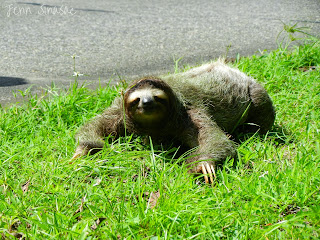 |
| Harpy Eagle at the Canopy Tower |
It was one of those moments, to see a Harpy Eagle in the wild, it doesn't get much better than that. However, for me, it did. The immense eagle perched comfortably with her back to us; once I saw her in the scope, I could see that this bird had an antenna on its back, extending from a radio transmitter. I immediately knew she was a bird released by the Harpy Eagle Conservation and Research project operated by the Peregrine Fund. I first came to Panama in November of 2008 to volunteer on this project, a very rewarding experience for me, and had the privilege to track several Harpy Eagles in Soberania National Park and learn about their behaviour and conservation. The question was, who was it??
Trying my best not to startle the bird, I slowly found a good spot to hopefully see her identification band. Persistence paid off and from a narrow angle looking up, I could see a faint "LV" on the blue band around its leg. It was LV! I couldn't believe it. LV is a very special bird. Here is her story.
In 2008, a young Harpy Eagle was shot in Darien. Likely still in her nest tree, and being tended to by devoted parents who had spent over a year and a half devotedly feeding and nurturing the eaglet. Luckily, in her injured state, she was reported to officials in Panama and was rescued and brought to Panama City. In the excellent hands of Peregrine Fund biologists and veterinarians, she had a surgery to repair her right wing, which sustained the injury. When she gained enough strength, it was determined that she was a possible candidate for release. To ensure her well-being, she was fitted with a VHF radio transmitter and PTT satellite transmitter, so the staff and volunteers could keep a close eye on her. They also placed a sturdy metal band around her right leg, with the initials "LV". She was released into Soberania National Park on March 9, 2009. She was an estimated 2 years of age at her time of release.
 |
| LV being released along Pipeline Road |
I was volunteering on the project at the time and was there for her release. Her release was surreal for me, she was the only bird I saw released during my 7 months on the project, and I had the pure joy of following her and tracking her progress for 4 months of my time here. When she was released, she had a rather shaky first flight to a low branch along Pipeline Road. But she grew stronger and stronger every day. Unsure if she had even started catching her own prey in the wild at her estimated age, we fed her every week, week after week. We affectionately called her "Love". And then on April 26, 2009, another milestone happened with LV. We found her, along a beautiful ravine deep in the national park, with a freshly-killed Hoffmann's Two-toed Sloth strung over a branch. I will never forget the excitement and accomplishment I felt for her (and us!) that day.
 |
| LV on April 18, 2009 |
When I left Panama in June 2009 after my time volunteering on the project, I said goodbye to LV for what I thought was the last time. But on September 24, 2014, beyond all expectations, there she was standing in front of me, 5½ years after her release, now in full adult plumage, incredibly beautiful, with every feather in perfect condition and no indication of ever having a wing injury.
 |
| LV, as beautiful as ever in 2014 |
During the two hours she perched beside the Canopy Tower, we watched her movements--her floppy crest bouncing around with every head movement, brief preening sessions, and she was well aware of our presence as she looked down at us on occasion. Then, she shifted her weight and opened her broad wings and flew down into the valley, out of sight. We were amazed at her immense size when she flew. We continued to hear her occasionally throughout the morning, she let us know that she wasn't far.
I like to think that she came back for a visit, to let us know she is doing well in the lowland forests of Soberania National Park. It is a great testament to the forest here, to be able to sustain a large forest eagle. We hope the very best for her.
~ Jenn














